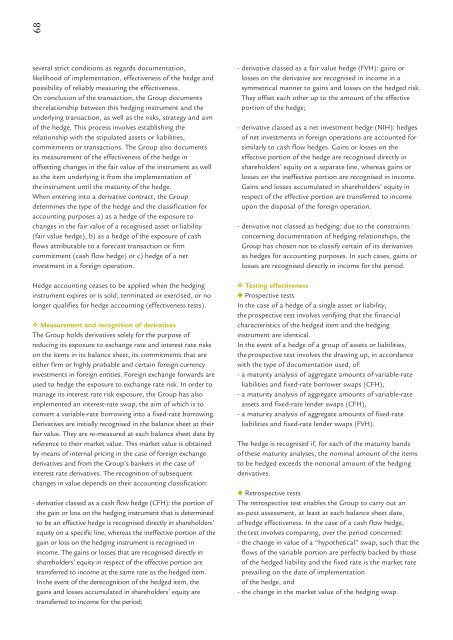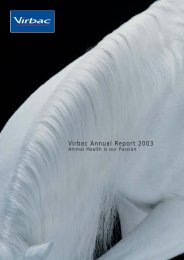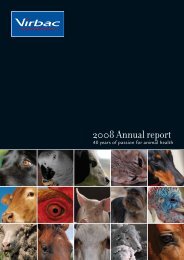2005 Annual report - Virbac
2005 Annual report - Virbac
2005 Annual report - Virbac
You also want an ePaper? Increase the reach of your titles
YUMPU automatically turns print PDFs into web optimized ePapers that Google loves.
68<br />
several strict conditions as regards documentation,<br />
likelihood of implementation, effectiveness of the hedge and<br />
possibility of reliably measuring the effectiveness.<br />
On conclusion of the transaction, the Group documents<br />
the relationship between this hedging instrument and the<br />
underlying transaction, as well as the risks, strategy and aim<br />
of the hedge. This process involves establishing the<br />
relationship with the stipulated assets or liabilities,<br />
commitments or transactions. The Group also documents<br />
its measurement of the effectiveness of the hedge in<br />
offsetting changes in the fair value of the instrument as well<br />
as the item underlying it from the implementation of<br />
the instrument until the maturity of the hedge.<br />
When entering into a derivative contract, the Group<br />
determines the type of the hedge and the classification for<br />
accounting purposes a) as a hedge of the exposure to<br />
changes in the fair value of a recognised asset or liability<br />
(fair value hedge), b) as a hedge of the exposure of cash<br />
flows attributable to a forecast transaction or firm<br />
commitment (cash flow hedge) or c) hedge of a net<br />
investment in a foreign operation.<br />
Hedge accounting ceases to be applied when the hedging<br />
instrument expires or is sold, terminated or exercised, or no<br />
longer qualifies for hedge accounting (effectiveness tests).<br />
❖ Measurement and recognition of derivatives<br />
The Group holds derivatives solely for the purpose of<br />
reducing its exposure to exchange rate and interest rate risks<br />
on the items in its balance sheet, its commitments that are<br />
either firm or highly probable and certain foreign currency<br />
investments in foreign entities. Foreign exchange forwards are<br />
used to hedge the exposure to exchange rate risk. In order to<br />
manage its interest rate risk exposure, the Group has also<br />
implemented an interest-rate swap, the aim of which is to<br />
convert a variable-rate borrowing into a fixed-rate borrowing.<br />
Derivatives are initially recognised in the balance sheet at their<br />
fair value. They are re-measured at each balance sheet date by<br />
reference to their market value. This market value is obtained<br />
by means of internal pricing in the case of foreign exchange<br />
derivatives and from the Group’s bankers in the case of<br />
interest rate derivatives. The recognition of subsequent<br />
changes in value depends on their accounting classification:<br />
- derivative classed as a cash flow hedge (CFH): the portion of<br />
the gain or loss on the hedging instrument that is determined<br />
to be an effective hedge is recognised directly in shareholders’<br />
equity on a specific line, whereas the ineffective portion of the<br />
gain or loss on the hedging instrument is recognised in<br />
income. The gains or losses that are recognised directly in<br />
shareholders’ equity in respect of the effective portion are<br />
transferred to income at the same rate as the hedged item.<br />
In the event of the derecognition of the hedged item, the<br />
gains and losses accumulated in shareholders’ equity are<br />
transferred to income for the period;<br />
- derivative classed as a fair value hedge (FVH): gains or<br />
losses on the derivative are recognised in income in a<br />
symmetrical manner to gains and losses on the hedged risk.<br />
They offset each other up to the amount of the effective<br />
portion of the hedge;<br />
- derivative classed as a net investment hedge (NIH): hedges<br />
of net investments in foreign operations are accounted for<br />
similarly to cash flow hedges. Gains or losses on the<br />
effective portion of the hedge are recognised directly in<br />
shareholders’ equity on a separate line, whereas gains or<br />
losses on the ineffective portion are recognised in income.<br />
Gains and losses accumulated in shareholders’ equity in<br />
respect of the effective portion are transferred to income<br />
upon the disposal of the foreign operation.<br />
- derivative not classed as hedging: due to the constraints<br />
concerning documentation of hedging relationships, the<br />
Group has chosen not to classify certain of its derivatives<br />
as hedges for accounting purposes. In such cases, gains or<br />
losses are recognised directly in income for the period.<br />
❖ Testing effectiveness<br />
◆ Prospective tests<br />
In the case of a hedge of a single asset or liability,<br />
the prospective test involves verifying that the financial<br />
characteristics of the hedged item and the hedging<br />
instrument are identical.<br />
In the event of a hedge of a group of assets or liabilities,<br />
the prospective test involves the drawing up, in accordance<br />
with the type of documentation used, of:<br />
- a maturity analysis of aggregate amounts of variable-rate<br />
liabilities and fixed-rate borrower swaps (CFH),<br />
- a maturity analysis of aggregate amounts of variable-rate<br />
assets and fixed-rate lender swaps (CFH),<br />
- a maturity analysis of aggregate amounts of fixed-rate<br />
liabilities and fixed-rate lender swaps (FVH).<br />
The hedge is recognised if, for each of the maturity bands<br />
of these maturity analyses, the nominal amount of the items<br />
to be hedged exceeds the notional amount of the hedging<br />
derivatives.<br />
◆ Retrospective tests<br />
The retrospective test enables the Group to carry out an<br />
ex-post assessment, at least at each balance sheet date,<br />
of hedge effectiveness. In the case of a cash flow hedge,<br />
the test involves comparing, over the period concerned:<br />
- the change in value of a “hypothetical” swap, such that the<br />
flows of the variable portion are perfectly backed by those<br />
of the hedged liability and the fixed rate is the market rate<br />
prevailing on the date of implementation<br />
of the hedge, and<br />
- the change in the market value of the hedging swap.








